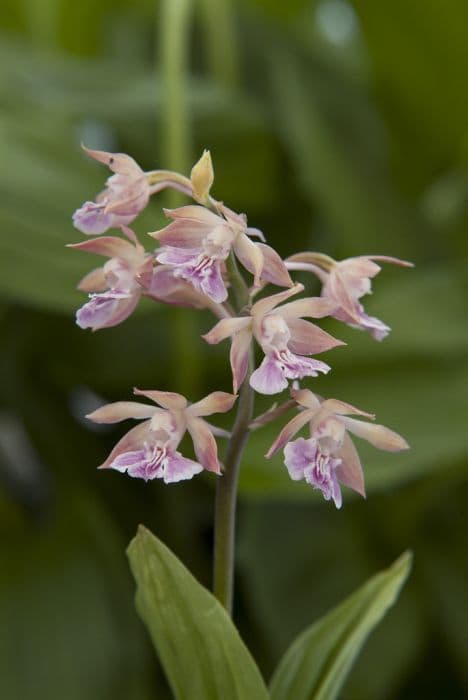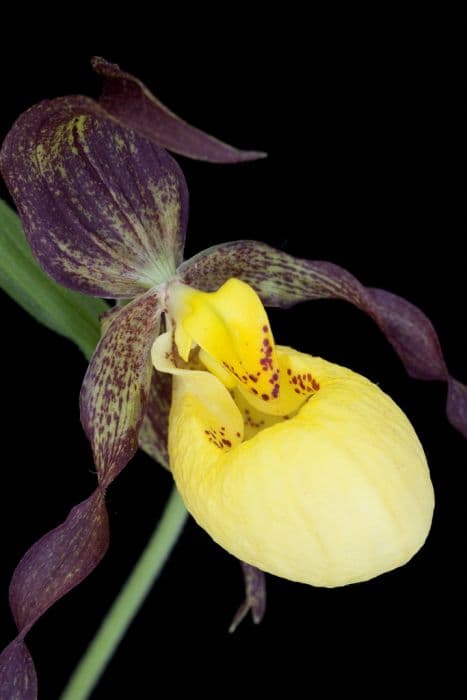White Lady's Slipper Cypripedium Bernd gx white-flowered

ABOUT
The Cypripedium Bernd gx white-flowered, commonly known as the White Lady's Slipper orchid, showcases stunning, showy blooms that make it a prized jewel among plant enthusiasts. Its appearance is characterized by a distinct pouch-like lip, resembling a slipper; this feature is prominent in its flowers which are predominantly white, giving it an air of purity and elegance. The bloom may also feature delicate veining or slight blushes of pale color, adding depth and intrigue to its visual appeal. Each flower is complemented by a set of petals and sepals, which can sometimes have hints of green or pink, gracefully framing the central pouch. The foliage of the White Lady's Slipper orchid consists of strappy, green leaves that emerge in a spiral pattern from the base of the plant, creating a pleasing contrast with the white blossoms. The leaves can be lush and are often a pleasing backdrop to the dramatic flowers. This plant's beauty and unique floral structure captivate many who appreciate the grace of orchids.
About this plant
 Names
NamesFamily
Orchidaceae
Synonyms
White-Flowered Bernd's Lady's Slipper, White-Flowered Bernd's Slipper Orchid, White Bernd's Cypripedium
Common names
Cypripedium Bernd gx white-flowered.
 Toxicity
ToxicityTo humans
The plant referred to as Cypripedium Bernd gx white-flowered is more commonly known as Lady's Slipper orchid. While they are not considered highly toxic to humans, caution is advised as they can cause skin irritation due to the presence of chemicals that can trigger contact dermatitis. Ingesting any part of the Lady's Slipper orchid is not recommended as it could lead to mild gastrointestinal symptoms such as nausea or diarrhea. It is important to handle this plant with care and ensure it is not consumed.
To pets
Regarding pets, the Lady's Slipper orchid is similarly non-toxic but may cause mild gastrointestinal upset if ingested by animals such as dogs or cats. Symptoms could include vomiting or diarrhea, but significant toxicity is unlikely. It is still best to prevent pets from chewing on or consuming parts of the orchid to avoid any potential discomfort or adverse reactions.
 Characteristics
CharacteristicsLife cycle
Perennials
Foliage type
Deciduous
Color of leaves
Green
Flower color
White
Height
1-2 feet (30-60 cm)
Spread
1 foot (30 cm)
Plant type
Herb
Hardiness zones
4-8
Native area
Asia
Benefits
 General Benefits
General Benefits- Aesthetic Appeal: The white flowers of the Lady's Slipper Orchid add elegance and beauty to gardens and indoor spaces.
- Habitat Support: This orchid can be part of a habitat garden that supports local wildlife, particularly pollinators.
- Cultural Significance: Orchids have a rich history and symbolize love, luxury, beauty, and strength in various cultures.
- Education and Research: As a unique and intricate plant, the Lady's Slipper Orchid offers opportunities for botanical study and education.
- Conservation Value: Growing endangered species like this orchid can help in conservation efforts by raising awareness of plant diversity and the need to protect natural habitats.
- Therapeutic Horticulture: Tending to orchids like the Lady's Slipper can be therapeutic, offering a rewarding and calming hobby for plant enthusiasts.
 Medical Properties
Medical PropertiesThis plant is not used for medical purposes.
 Air-purifying Qualities
Air-purifying QualitiesThis plant is not specifically known for air purifying qualities.
 Other Uses
Other Uses- Photography subject – The Cypripedium Bernd, known commonly as the Lady Slipper Orchid, with its unique white flowers, can be a sought-after subject for nature and macro photographers.
- Education and Research – Botanists and horticulture students may study this orchid to understand the intricacies of orchid hybridization and flower development.
- Conservation Indicator – Since orchids are sensitive to environmental changes, Lady Slipper Orchids can be used as indicator species for the health of their habitat ecosystems.
- Floral Arrangements – Although not commonly used due to their rarity, they can add exotic appeal to bespoke and high-end floral arrangements.
- Artistic Inspiration – Artists may draw inspiration from the striking appearance of the Lady Slipper Orchid for paintings, drawings, and textile designs.
- Bee Attraction in Gardens – They can be planted to attract pollinators like bees, contributing to the health of the garden's micro-ecosystem.
- Cultural Significance – In some cultures, orchids like the Lady Slipper hold symbolic meanings and could be used in ceremonial contexts.
- Eco-Tourism – Gardens and conservatories featuring this orchid may serve as attractions for eco-tourists.
- Crafts and Decorations – The orchid’s unique pouch-like structure can inspire designs in ceramics and home decorations.
- Collectors' Item – Orchid enthusiasts may seek out this particular hybrid to add to their plant collections due to its distinctive attributes.
Interesting Facts
 Feng Shui
Feng ShuiThe Lady Slipper Orchid is not used in Feng Shui practice.
 Zodiac Sign Compitability
Zodiac Sign CompitabilityThe Lady Slipper Orchid is not used in astrology practice.
 Plant Symbolism
Plant Symbolism- Rarity: A white-flowered variation of a Cypripedium, commonly known as Lady's Slipper Orchid, can be rare, symbolizing uniqueness and preciousness.
- Femininity: The Lady's Slipper Orchid resembles a delicate, feminine shoe, representing beauty and grace typical of feminine energy.
- Protection: Orchids in general are often associated with safety and protection due to their nurturing growth environments.
- Refinement: The Lady's Slipper Orchid is a symbol of high-class and luxury, due to its exquisite appearance and association with sophisticated environments.
- Capriciousness: Their specific growing requirements reflect the idea of whimsical or unpredictable behavior, much like a capricious person.
 Water
WaterFor the Lady's Slipper Orchid, water thoroughly once the top inch of the soil feels dry to the touch. This typically translates to once a week, but frequency may vary depending on environmental conditions such as temperature and humidity. Use room temperature water, and provide around a quart for a standard-sized pot, ensuring that excess water is allowed to drain. During the plant's dormancy in winter, reduce watering but do not allow the soil to completely dry out.
 Light
LightThe Lady's Slipper Orchid thrives in bright, indirect sunlight. It should be placed near a window that receives filtered light but protected from the direct harsh rays of the sun, especially during midday, to avoid scorching the leaves. A north or east-facing window is often ideal for these light requirements.
 Temperature
TemperatureLady's Slipper Orchids prefer a temperature range between 50°F and 75°F. They can tolerate a dip down to around 40°F and can withstand up to 80°F, but should not be exposed to extremes beyond these limits. Maintain a consistent temperature to avoid stressing the plant.
 Pruning
PruningLady's Slipper Orchids should be pruned to remove dead or damaged foliage, which helps prevent disease and pests. Prune after flowering by cutting back the flower stem to the base with sterile scissors. Caroling should be done annually or as needed when the plant is not in active growth, typically in late fall or winter.
 Cleaning
CleaningAs needed
 Soil
SoilLady's Slipper Orchids like Cypripedium Bernd prefer a well-draining soil mix consisting of equal parts perlite, pine bark, and peat with a pH ranging from 5.5 to 7. This mix ensures good aeration and moisture retention without waterlogging the roots.
 Repotting
RepottingLady's Slipper Orchids should generally be repotted every 2 to 3 years or when the growing medium begins to break down, whichever comes first, to maintain health and vigor.
 Humidity & Misting
Humidity & MistingLady's Slipper Orchids thrive in moderate to high humidity levels, ideally around 40-50%. Maintaining these humidity levels can create an optimal growing environment for the plant.
 Suitable locations
Suitable locationsIndoor
Provide bright, indirect light and maintain moderate humidity.
Outdoor
Ensure dappled sunlight, shelter from harsh weather, and moist soil.
Hardiness zone
4-8 USDA
 Life cycle
Life cycleThe plant commonly known as the White-Flowered Lady's Slipper undergoes a perennial life cycle. It starts as a seed, which, after being dispersed, requires a symbiotic relationship with specific soil fungi to germinate—a process that can take several months to years. Upon successful germination, a tiny protocorm (a specialized structure that acts as an intermediary between the seed and the first true leaves) is formed, which develops into a small seedling with the characteristic leaves of the genus Cypripedium. Over several years, the plant slowly matures, eventually forming a robust root system and multiple shoots. Following maturation, typically between the ages of 4 to 16 years, it blooms in late spring or early summer, displaying its distinctive white pouch-like flowers. After pollination and seed formation, the plant enters a period of dormancy during winter, to emerge again in the next growing season.
 Propogation
PropogationPropogation time
Spring-Early Summer
The Lady Slipper Orchid, often referred to by its botanical name Cypripedium, is a unique and enchanting plant that requires specific propagation conditions. The white-flowered variety known as Cypripedium Bernd gx benefits from propagation during its dormant period, usually in the late fall to early spring. Division is the most popular method for propagating these delicate orchids. This involves carefully removing the plant from its growing medium and gently separating the rhizomes, ensuring that each division has at least one growth point. The divisions are then potted individually in a suitable orchid mix and maintained in conditions that replicate their natural habitat – cool, humid, and well-ventilated environments. This approach maintains the genetic integrity of the parent plant while helping to increase the number of plants over time. It is a meticulous process that requires sterilized tools and a gentle touch to prevent damage to the rhizomes and roots.









